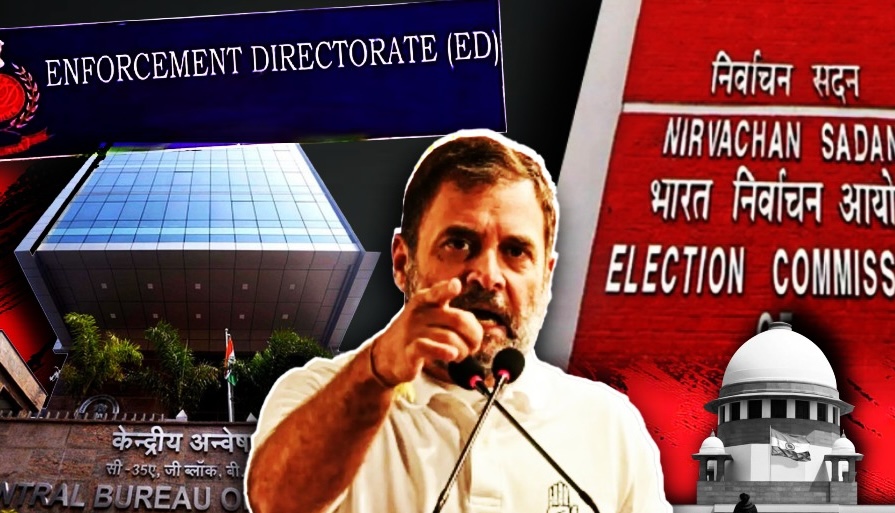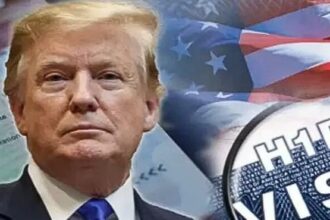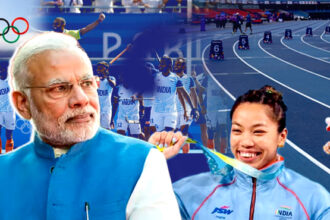“Votes are stolen!”
“Democracy is dead!”
“Button koi bhi dabao, vote BJP ko hi jayega!”
“The CBI, ED are compromised!”
The opposition has perfected the art of scorched earth theory. They have figured out that Modi is invincible as the prime minister and they have resigned to their fate of being in opposition for as long as Modi contests the elections. But if you cannot help in nation building, you can always destroy the very fabric of the nation. And what better way than seeding doubts in the minds of common citizens.
Modi at Centre
India is a diverse country of over 150 crore people. The political landscape of India has changed quite significantly since 2014 when Narendra Modi came to power at the Centre. It is not that India was not political or polarised on ideological grounds before that. But Modi’s rise to power coincided with the internet reaching the villages and the advent of social media. The discussions that took place at a nearby chai ki tapri were now happening on social media.
This meant the politicians needed to come up with newer strategies to disrupt as the old ones were being easily called out and were getting redundant.
Thus came the gaslighting. You plant the seed of doubt in the minds of the people so much that they start questioning everything around. Things they had trusted for years – that is the very democratic process.
Rahul Gandhi, with the help of his loyal courtiers, in the past few years has mastered the art of manipulating Indian voters. He has chosen ‘creating doubt in the minds of people’ as the weapon of choice.
Aap chronology samajhiye
It all started back in 2023, just a year ahead of 2024 general elections. Mood of the nation was very clear even then that Narendra Modi was returning to power for the third consecutive term. That is where a so-called research paper was published by a professor at Ashoka University.
In July 2023, Sabyasachi Das, Assistant Professor at Ashoka University published the paper. It was titled ‘Democratic Backsliding in the World’s Largest Democracy’. It suggested that in 2019, the BJP came to power at the Centre for the second time by widescale electoral manipulation. It insinuated electoral fraud while making some damning allegations. Das also suggested that there was discrimination against Muslim voters. The only objective of this so-called research paper was to cast doubt on India’s electoral process and credibility of democratic institutions. It did not have any substance and findings based on the unscientific methodology were inconclusive, but the allegations were enough for the opposition to weaponise it.
Despite being debunked conclusively, the damage had been done.
Misuse of Supreme Court by propagandists
The usual suspects have started building up the narrative. Propagandist masquerading as an advocate, Prashant Bhushan knocks the doors of the Supreme Court, casting doubts and aspersions on the EVMs or the electronic voting machines and the paper slips produced by the voter verified paper audit trail or the VVPAT.
The whole intention behind such petitions amid the 2024 Lok Sabha elections was to damage the public psyche who have been told repeatedly by politicians that whichever button you may press, the vote will go to the BJP. This could make an average voter feel that their ‘votes’ are stolen – and that if a BJP candidate wins that seat, it has to be because of vote manipulation and not because people there actually voted for him.
Interestingly, the ‘vote chori’ narrative is never brought up when the non-BJP party is winning the state election. Like, no one is questioning Mamata Banerjee’s returning to power in West Bengal by vote manipulation – somehow, whenever a non-BJP party wins any election, it is peddled as restoration of democracy and if BJP wins, democracy is compromised.
Ahead of 2024 elections, multiple propagandists, such as Paranjoy Guha Thakurta to Aakar Patel to Prashant Bhushan to Yogendra Yadav – all had joined forces to suggest large-scale voter manipulation and fraud. Foreign media was also hand in glove with the puppets of regime change operations for constantly suggesting the democracy in India is compromised. Indian darbari and Congress friendly journalists and YouTubers such as Rajdeep Sardesai, Ravish Kumar, Ajit Anjum, Arfa Khanum Sherwani – all worked overtime to hammer into an average voters’ mind that the elections in India are not fair and democratic.
Manipulated media as tool for propaganda
At this point, in the middle of elections, an out of context, manipulated video of Home Minister Amit Shah is circulated by Congress and Congress supporters where voters were made to believe that if BJP comes back to power in 2024, the SC/ST and OBC reservation would be abolished. While the video was eventually debunked, the damage was done. A majority of the voter base was made to believe that the reservations would be abolished.
When the Election Commission took up the Special Intensive Revision (SIR) exercise ahead of Bihar state assembly elections, the Modi haters got into activism mode. Yogendra Yadav moves the Supreme Court over the same seeking a stay on the process. Yogendra Yadav has been an advisor to Rahul Gandhi ahead of 2024 elections and was part of the said ‘super PMO’ – that is the NAC (National Advisory Committee) headed by Sonia Gandhi during the UPA era which superseded even Prime Minister Dr Manmohan Singh.
Let it also be known that the SIR is a process carried out by the Election Commission so that no eligible voter is left out of the voting list and no ineligible voter, such as deceased voters or duplicate entries. To a sane individual who has faith in democracy this would appear like a logical move. But not for professional protestors and propagandists like Yogendra Yadav.
But not for politicians who could again weaponise the move to play with the voters’ minds. This is where Rahul Gandhi makes his grand entry. In November 2024, Congress alleged voter manipulation. In fact, Congress President Mallikarjun Kharge even wanted to turn back the wheels of time and go back to paper ballots. After all, not everyone can be graceful in defeat.
Anyway, the EC invited Congress to review the process over the concerns while asserting no discrepancy in voter turnout data. In December, the ECI published a response to Congress allegations. But Rahul Gandhi does not let facts get in the way of gaslighting. Hence, very recently he again raised the ‘fake voter’ bogey and raised the ‘voters are stolen’ narrative.
Resorting to his ‘shoot and scoot’ policy, Rahul Gandhi provided no proof for his allegations and refused to give his statement in a signed copy. After all, this would have led to an official and formal communication which could have consequences. And we all know Rahul Gandhi, in his two decades in politics, has wanted power minus any accountability.
Rahul Gandhi’s strategy
Rahul Gandhi has increasingly adopted a strategy of casting doubts on India’s democratic institutions and procedures to position himself as a challenger to the establishment. By repeatedly questioning the fairness of the Election Commission, the independence of investigative agencies, and the impartiality of the judiciary, he frames himself as a lone voice standing up to a supposedly compromised system.
As the world’s largest democracy, India has taken pride in robust election processes, but this manipulation where you are constantly suggesting that the scales are tilted in the favour of the BJP and against the opposition psychologically damages the trust of Indian voters. This leads to anxiety and voter distrust, making people naturally sympathetic to the leader who is ‘fighting the good battle’.
Instead of having to work and prove their credibility to win votes, Congress and other opposition are now seeking to discredit independent institutions to return to power. This is a precursor to a civil war – where one can’t even trust their own neighbour.
Till now, Rahul Gandhi has questioned and created doubts against the Election Commission, the CBI, the Enforcement Directorate – all independent institutions – as if they are being used as political tools by the government in power. One could argue that Rahul Gandhi is doing so because when Congress was in power, they did the same and hence he knows how these institutions can be compromised. But one needs to understand that there is a difference in the working style of Narendra Modi and Congress. That Modi has respected the sanctity of independent institutions even if they are not always working out in their favour. Because that is the essence of democracy. But Rahul Gandhi and Congress, who are used to having their way, find it hard to accept it.
To conclude, democracy is not ‘dead’. In fact, it is far from it. Rahul Gandhi is not defending democracy but undermining it.
In the drama being directed by Rahul Gandhi and Congress, doubt has emerged as a hero. He is weaponising doubts to mask his and his own party’s failures. He is not saving democracy but is making its hollow version to serve his own interests. This is his scorched earth policy.









